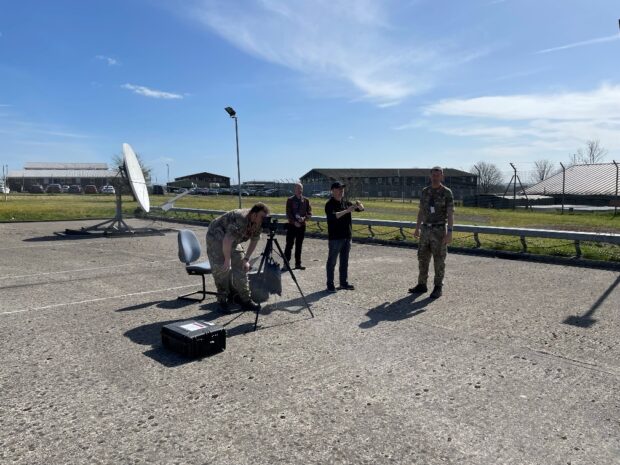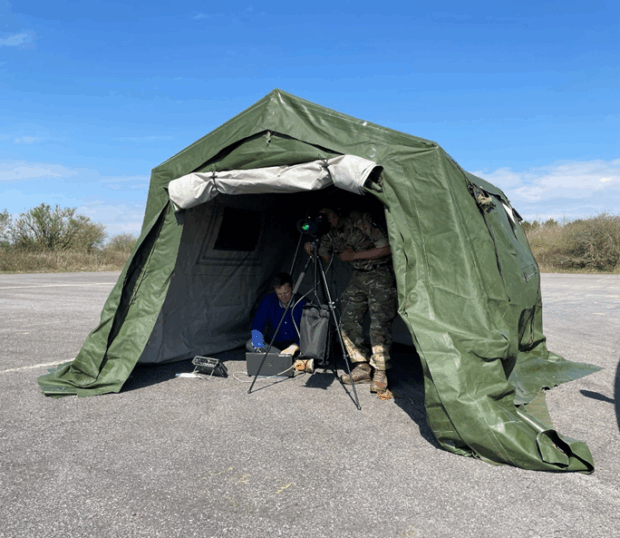In the ever-evolving landscape of military communications, the need for innovative solutions to address emerging challenges is paramount. As the electromagnetic spectrum becomes increasingly congested and contested, the search for alternative communication technologies has taken centre stage. One such promising avenue is Optical Wireless Communications (OWC), specifically Free Space Optical Communications (FSOC), which offers a non-radio frequency (RF) alternative for long-range, point-to-point wireless communications. Recently, I had the privilege of working with the Yeoman of Signals (YofS) students on an exciting OWC project sponsored by the Chief Technology Officer (CTO). This project not only explored the potential of FSOC technology but also provided a unique opportunity to engage with the next generation of military communicators.
Introducing the OWC Project
The OWC project was designed to investigate the feasibility and benefits of FSOC technology for military applications. FSOC uses light to transmit data through free space, offering a secure, high-bandwidth, and interference-free communication method. Unlike traditional RF systems, FSOC is immune to electromagnetic interference and does not contribute to the electromagnetic signature of a battlefield, making it an attractive option for dispersed Command Posts (CPs) and other tactical scenarios.
The project was sponsored by the CTO, who recognised the potential of FSOC to address critical challenges in modern military communications. To bring this vision to life, the YofS students were tasked with exploring the technology, understanding its benefits, and assessing its applicability for the warfighter. This hands-on approach not only allowed the students to engage with cutting-edge technology but also provided valuable insights for the CTO and the broader defence community.
Helping Students Learn About OWC Technology
One of the most rewarding aspects of this project was working closely with the YofS students to help them understand the intricacies of OWC technology. For many of them, this was their first exposure to FSOC, and it was inspiring to see their enthusiasm and curiosity as they delved into the subject.
We began by introducing the fundamental principles of FSOC, including how it uses lasers or LEDs to transmit data over long distances. The students quickly grasped the advantages of FSOC, such as its high data rates, low latency, and immunity to RF jamming. They were particularly intrigued by its potential to operate in environments where traditional RF systems might be compromised.
To deepen their understanding, we conducted a workshop and practical session, where the students had the opportunity to work with FSOC equipment and simulate real-world scenarios. These hands-on experiences were invaluable in helping them appreciate the challenges and opportunities associated with deploying FSOC technology in a military context.
The WOLF Field Trial: A Real-World Test of FSOC Technology
A standout moment of the project was the field trial conducted with a Defence and Security Accelerator (DASA)-funded FSOC system called WOLF, developed by AVOptics. This trial took place on a disused airfield at the Land Systems Test and Reference Centre (LSRC) at Blandford Camp in Dorset, providing an ideal environment to evaluate the system's performance in a realistic yet controlled operational setting. The WOLF system represented a cutting-edge implementation of FSOC technology, and the trial offered an invaluable opportunity to assess its feasibility for military use.
The main objective of the trial was to investigate the potential of FSOC technology to support the dispersion of Command Posts within a Combined Arms Manoeuvre (CAM) setting, thereby reducing electromagnetic signatures on the battlefield and improving survivability. By decreasing dependence on conventional RF communications, FSOC presents a promising approach to bolstering operational security and lowering the likelihood of detection by adversaries.
During the trial, the YofS students played a pivotal role in setting up and operating the WOLF system. Working alongside AVOptics engineers and military personnel, they established FSOC links across varying distances and terrain on the airfield. The trial presented several challenges, including maintaining a clear line-of-sight between the transmitter and receiver, mitigating the effects of atmospheric conditions, and ensuring the system's reliability in a dynamic environment.
Despite these challenges, the trial was a resounding success. The WOLF system demonstrated its ability to deliver high-speed, secure communications over significant distances, even in less-than-ideal conditions. The students gained hands-on experience in troubleshooting and optimising the system, and their feedback provided critical insights that will inform future development and deployment of FSOC technology.


Challenges and Successes
As with any innovative project, the OWC initiative encountered its share of challenges. One of the primary hurdles was the need to maintain a clear line-of-sight between the FSOC transmitter and receiver. This requirement can be difficult to achieve in complex battlefield environments, where terrain, obstacles, and movement can disrupt the optical link. The students quickly learned the importance of careful planning and site selection to maximise the system's effectiveness.
Another challenge was the impact of atmospheric conditions, such as fog, rain, and dust, on FSOC performance. These factors can attenuate the optical signal and reduce the system's range and reliability. The trial provided valuable data on how these conditions affect FSOC links and highlighted the need for robust mitigation strategies.
Despite these challenges, the project achieved several significant successes. The students demonstrated remarkable adaptability and problem-solving skills, and their contributions were instrumental in overcoming technical and operational obstacles. The trial also validated the potential of FSOC technology to enhance battlefield communications, providing a strong foundation for future research and development.
Implications for Military Communications
The insights gained from the OWC project have far-reaching implications for military communications. FSOC technology offers a viable alternative to RF systems, enabling secure, high-bandwidth communications in environments where RF is compromised or unavailable. Its ability to minimise electromagnetic signatures is particularly valuable for dispersed command posts, where operational security is paramount.
Looking ahead, FSOC technology could play a critical role in enabling next-generation military networks, supporting applications such as unmanned systems, sensor networks, and high-capacity data links. The lessons learned from the WOLF trial will inform ongoing efforts to refine and optimise FSOC systems for military use.
A Collaborative Success Story
Working with the YofS students on the OWC project was a truly rewarding experience. Their enthusiasm, creativity, and dedication were instrumental in the project's success, and it was inspiring to see them embrace the challenge of exploring a new technology. The project not only provided them with valuable skills and knowledge but also demonstrated the importance of collaboration between the military, industry, and academia in driving innovation.
For the CTO, the project offered a unique opportunity to engage directly with the end-users of emerging technologies. The insights gained from the students' experiences and feedback will be invaluable in shaping the future development and deployment of FSOC systems. This collaborative approach ensures that new technologies are not only technically feasible but also operationally relevant and effective.
Looking to the Future
The success of the OWC project has laid the groundwork for a continued partnership between the CTO and the YofS course. By fostering a culture of innovation and collaboration, we can ensure that the next generation of military communicators is well-equipped to tackle the challenges of the future battlefield.
As we look to the future, the potential of FSOC technology to transform military communications is clear. By continuing to invest in research, development, and training, we can unlock the full potential of this groundbreaking technology and deliver tangible benefits for the warfighter.
In conclusion, the OWC project was a shining example of how collaboration, innovation, and hands-on learning can drive progress in military communications. It was a privilege to work with the YofS students and contribute to this exciting initiative, and I look forward to seeing how FSOC technology continues to evolve and shape the future of defence communications.
Leave a comment